Introduction
When it comes to fountain pens, the nib is the heart and soul of the writing experience.
And if you're a beginner looking to delve into the world of fountain pens, you might have heard about a unique type of nib called the music nib.
But what exactly is a music nib? Well, let's find out.
A fountain pen music nib is a specialized nib designed to offer exceptional line variation, allowing you to create thick and thin strokes with ease.
Unlike traditional nibs that produce consistent line widths, a music nib adds a touch of artistry to your writing, akin to the expressive qualities found in music.
What is a Fountain Pen Music Nib?
Imagine a conductor leading an orchestra, skillfully guiding each instrument to produce a harmonious symphony.
In a similar vein, a music nib orchestrates your writing strokes, creating a visual melody on paper.
Here's what makes a music nib unique:
- Distinct Design: A music nib typically features two tines, each with a small slit that delivers ink to the paper. These dual tines offer greater line variation than other nib types.
- Line Variation: When held at a certain angle, a music nib produces wide downstrokes and fine cross-strokes, enabling you to achieve beautiful calligraphic effects and dynamic lettering.
- Inspired by Tradition: Music nibs draw inspiration from the world of calligraphy, where instruments like broad-edged pens were used to create stunning letterforms. With a music nib, you can add a touch of calligraphic elegance to your writing or sketches.
Advantages of Fountain Pen Music Nibs
Why should you consider using a music nib? Well, here are a few advantages that might sway you in its favor:
- Expressive Writing: Music nibs offer unparalleled expressiveness, allowing you to infuse your writing with personality and flair. Whether you're jotting down notes, creating artwork, or simply penning a heartfelt letter, the music nib adds a touch of artistic charm.
- Versatility: With a music nib, you can effortlessly switch between thick and thin lines, giving you the freedom to explore various writing styles and techniques. It's like having a versatile brush or calligraphy pen at your fingertips.
- Control and Stability: Thanks to its design, a music nib provides better control and stability while writing. The dual tines ensure a steady flow of ink and minimize the chances of blotting or skipping.
- Perfect for Calligraphy and Musical Notation: If you're interested in calligraphy or writing sheet music, a music nib is an excellent choice. Its wide downstrokes mimic the elegance of calligraphy pens, and the fine cross-strokes facilitate precise musical notation.
Using a Fountain Pen Music Nib
Now that you're intrigued by the allure of a music nib, let's dive into how to make the most of it:
- Hold it Right: To maximize the nib's potential, hold the pen at a comfortable angle of around 45 degrees. Experiment with different grips and find what feels natural to you.
- Paper Matters: Choose smooth, high-quality paper that complements the ink flow of the music nib. Avoid rough or absorbent surfaces that can hinder the nib's performance.
- Varying Line Widths: Applying different pressure levels while writing or sketching allows you to control the line width. Experiment with light, medium, and heavy pressure to create a symphony of strokes.
-
Practice and Experiment: Like any skill, using a music nib takes practice. Try
different writing styles, stroke techniques, and ink combinations to discover your unique artistic voice.
Maintaining and Caring for Fountain Pen Music Nibs
To keep your music nib in prime condition, follow these care tips:
- Regular Cleaning: Prevent ink clogs or residue buildup by cleaning your pen regularly. Flush the nib and feed with lukewarm water until the water runs clear, then dry it gently with a soft cloth.
- Nib Adjustments: If you experience any issues with ink flow or consistency, consider having a professional adjust the nib. They can make minor tweaks to optimize its performance and ensure a smooth writing experience.
- Proper Storage: When not in use, store your fountain pen with the nib facing up or horizontally. This prevents ink from settling at the base of the nib and helps maintain its functionality over time.
Frequently Asked Questions (FAQ)
Why is it called a music nib?
The term "music nib" is used because this type of nib is specifically designed for writing music notation. Its unique shape and characteristics allow for producing different line widths in a single stroke, making it ideal for musical composition.
What is a music nib used for?
A music nib is primarily used by musicians, composers, and calligraphers for writing music sheets and scores. Its broader tip enables writing musical symbols and notations with varying line widths, providing more expressiveness and artistic flair to the music.
What is the difference between a stub nib and a music nib?
While both stub nibs and music nibs create line variations, there are some key differences between them. A stub nib has a flat tip, resulting in horizontal line variations when held at a consistent angle. On the other hand, a music nib has multiple tines that create both horizontal and vertical line variations, allowing for more versatile writing, particularly suited for music notation.

